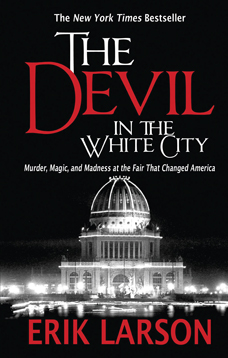Darkness hides in the brightest jewel
 CREDIT: CROWN PUBLISHING GROUP
CREDIT: CROWN PUBLISHING GROUPAs the white buildings and bright lights of the World's Fair gleam, bloody footprints walk the halls of a nearby hotel...
If you could travel back in time, to anywhere in the world, where would you go? Would you shake hands with Susan B. Anthony? Ride the very first Ferris wheel? Watch the first movies ever made under the bright lights of the new AC current? Would you drink the first Pabst or chew the first Juicy Fruit?
For a brief, magical moment in the 1890s, one could do all of this in one city — Chicago. As you wander through the wondrous White City, jewel of the World's Columbian Exposition, you could stand in awe for hours at the architectural and engineering marvels standing before you. A collection of marvels beyond any seen before, and an inspiration for builders and artists generations after the final ticket sold.
This creation came at a price, however, paid by the hundreds of men and women who lost their lives constructing, running and visiting the fair. As Erik Larson reveals in The Devil in the White City, with a man like H. H. Holmes haunting the streets, visiting may have been the most dangerous activity at all.
Throughout the book, Larson flips back and forth between the geniuses behind the White City and the man who prowled its streets. Plans for the beautiful white buildings were made as Holmes designed and built his own dark counterpoint, a dark castle that would go down in infamy as the Murder Hotel.
An amazing feature of the book is its ability to turn idolized, or demonized, historical figures into the very real people they were. Whether working on the fair or employed by one of America's most charismatic murderers, everyone is fleshed out, with their personality shining through ink and paper.
Perhaps most interesting is Larson's focus on those who lost their lives while under Holmes' dark spell. Each of the women married to the man is described with compassion and understanding, their story told in full. While Holmes takes place at the forefront of the tale, these women and children are far from forgotten.
There are moments when the tale feels unbalanced, focused more on the fair than on the killer the title suggests the book is about. The play between the historical significance of the World's Columbian Exposition and the man thought of as America's first true serial killer is truly unique.
As one reads of the remarkable amount of work put into the fair, it becomes more and more depressing that it remained in the minds of many as a time of woe. With murder, fires and civil unrest following on its heels, Chicago's White City quickly turned from the triumph of the industrial age to its darkest chapter.
Writing with knowledge, insight and a gift for storytelling, Erik Larson is able to take a series of historical events and turn them into a rich tale of wonder and suspense. With a movie adaptation rumoured to be on its way, it seems as though Chicago may never escape its haunted past.














